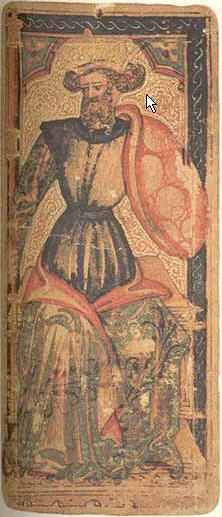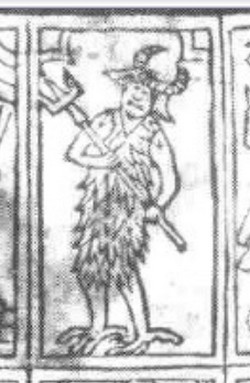Introduction
This is a short note, just to communicate as soon as possible something that can support the recent discovery by Thierry Depaulis of the earliest quotation of Trionfi known at present.(1) This new information has been found in an account book that had been indicated to me by the same historian, after an unknown article (I mean in our field) written by Dario A. Covi.(2)
For a description of the Archivio dell’Ospedale degli Innocenti,(3) and even of the account book in question, I can directly refer to a previous note.(4) There I reported and discussed a lot of new data about Naibi sold by silk-dealers. At present, I am near to finish this whole research with a similar study on the Naibi packs acquired by the same silk-dealers and am compiling a report on this. As stated at the beginning, this is a preliminary information from that source, which seems to me more urgent to be known.
1440-1621 entry
As I wrote a few days ago,(5) we have recently got a new list of dates: 1440 first record of "Naibi a trionfi" in the original Giornali by Ser Giusto Giusti; 1621 oldest extant copy by Carlo Strozzi; 2002 transcription by Nerida Newbigin; 2012 retrieval of the previous info by Thierry Depaulis.(1)
Obviously, the most important of the dates above is 1440, the earliest date known for a game of Trionfi, except the special Milanese pack introduced by Marziano. However, there is no possibility to discover the original manuscript written by Giusto Giusti. Not only. Out of the five manuscripts taken into account by Nerida Newbigin, the relevant text is only present in one and only one of them.(6)
Therefore, when I wanted to check this quotation, I only could verify that the paragraph in question was really absent in three of the four manuscripts found in Florence. I could not check its absence in the fifth manuscript, kept in Paris, but this is stated to consist in just a couple of leaves, and with chronicles of a different date.
I could thus check the relevant text in the only one manuscript where it is still preserved. The idiom "Naibi a trionfi" is clearly readable there and cannot have been transcribed wrongly, except the use of initial capital letters or similar small differences that have been introduced, intentionally, in the printed version.
The problem is thus reduced to discuss whether this text, written in 1621, and only recently known, could exactly correspond to an original version of almost two centuries before. Of course a copyist of the 17th century could interpolate one or two words in an earlier text. I would say that this could be much more likely than the case of a writer of the 15th century interpolating a text of the 17th – I have inserted this illogical example, because for me the probability in our special case is practically the same in both directions. Actually, nobody in the 17th century could think here of "Naibi a trionfi", had he not this outdated and forgotten expression under his own eyes. In conclusion, I feel certain that the unknown writing of 1440 exactly corresponded to what has been kept in the 1621 copy.
If however the same virtual comparison is extend to the whole paragraph, something may have been different in the two versions; namely, the price. In my opinion - but may be wrong - the word ducati was not written in the original as a whole word, the same as we read in the copy. I rather imagine that the usual symbol for L. was present there, a price of L.4s.10 (or of 90s., as I am recently accustomed to write the costs of our card packs), is already high enough for an artistic pack, ordered as an individual item of finer quality and also painted with the coats of arms of the beneficiary.
The question is however worth of further discussion, remembering some prices of Florentine cards from the Este archives: "nel 1434 il Marchese Nicolò III faceva pagare a Ser Ristoro e compagni in Firenze sette fiorini d’oro prezzo di due mazzi di carticelle mandatogli a Ferrara" (Campori 1874). I feel further data are needed before a definite solution can be found. What follows may be included in that discussion too. It does not come from 1440, but one dozen years is a much shorter time interval with respect to two centuries, as indicated above.
The document
The entry in question is reproduced below. The handwriting is easier than average to read and "Naibi di trionfi" can be read here. It is not likely that this expression should instead be read "Naibi a trionfi", but the form and the meaning is practically the same.
Here is the quotation. (I hope to obtain the authorisation to reproduce the page, in occasion of my next report on the same book.)
«Sabato adì 29 di luglio [1452]
....
Antonio di Dino fa i naibi L. otto e s. otto sono per dodici paia di naibi di trionfi a s. xiiii paio portò Dino contanti..... L. viii s. [viii - missing]»(7) |
The fact that the sum of 8s. is not reported near the 8L. on the right border is something that is not common, but is not very rare as well. On the basis of other data, a unit price of 14s. for a pack of Trionfi in that year is not surprising at all. Of course, it is impossible to extrapolate in a reliable way from here towards earlier times, for which records of Trionfi and their prices have not yet been found.
However, even before Trionfi appeared on the market, there was a rather unexpected great variation in the prices of Naibi, depending on their quality. The most expensive among Naibi packs could easily pass the value of 20s.
Conclusion
I have discussed here just one entry recorded in one account book of silk-dealers, already described,(4) and which will soon be the source of new data on the trade of Naibi and Trionfi in Florence in the 15th century. Its date in July 1452 is not too early, a dozen years later with respect to the similar mention, written in the Giornali of Ser Giusto Giusti.(1) A particular advantage of this new document, and its date, is that it supports the idiom of "Naibi a trionfi", or the alternative form of "Naibi di trionfi", which we only knew directly from the copy of 1621 by Carlo Strozzi.
The special value of these expressions is that they explicitly, and definitely, insert the appearance of Trionfi into the mainstream of playing cards.
Footnotes:
(1) Thierry Depaulis, Personal Communication, 01.02.2012; Web discussion: Florence 1440 - New Earliest Reference to Tarot
(2) Thierry Depaulis, Personal Communication, 04.02.2012 ; Dario A. Covi, Prospettiva, No. 12 (1978) 61-72.
(3) Archivio dell'Ospedale degli Innocenti di Firenze ; Franco Pratesi: Naibi on Sale (2012)
(4) Franco Pratesi: Naibi sold by Silk dealers (2012)
(5) Franco Pratesi: Germini among other games (2012)
(6) BNCF, Fondo Nazionale, II, II, 127.
(7) AOIF, 12793, "Uscita C", (1446-1461), 1452, l.64r.
Side bar pictures and text added by Lothar Teikemeier
|

A "dozen" (= 12) is - for the current moment - the highest number of Trionfi card decks, which is recorded in documents till 1463. Then the surprizing high number of 309 ("para 309") in a custom register document in Rome 1464 gives a clear indication, that mass production has arrived in processes of the Trionfi card production, possibly accompanied by the start of the Minchiate development in Florence (the earliest reference to Minchiate appeared in a letter from the poet Luigi Pulci to the young Lorenzo di Medici in 1466). It's not totally clear, but possibly these later products gave impressions like those in the Rosenwald Tarocchi.

|
|

